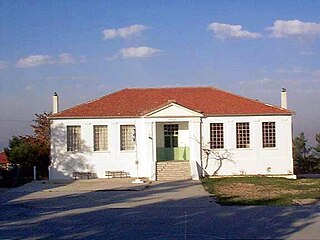 W
WChalkidiki also spelled Chalkidike, Chalcidice, Khalkidhiki, or Halkidiki, is a peninsula and regional unit of Greece, part of the Region of Central Macedonia, in the geographic region of Macedonia in Northern Greece. The autonomous Mount Athos region constitutes the easternmost part of the peninsula, but not of the regional unit.
 W
WThe Archaeological Museum of Polygyros is a museum in Polygyros, Chalkidiki, in Greece. The museum is located in Iroou Square in the town centre and displays representative archaeological finds from all over Chalkidiki. More specifically, they cover a span of time ranging from the Bronze Age to the Roman period and come from ancient Stageira, Toroni, Pyrgadikia, Aphytos, Polygyros, Ierissos, Stratoni, as also from the ancient city of Olynthos. Museum is currently closed for complete reconstruction. The Archaeological Museum of Polygyros was closed in January 2012 and reconstruction began in May 2012. Completion of reconstruction is expected sometime in summer 2014.
 W
WAris Palaiochori Football Club is a Greek football club based in Palaiochori, Chalkidiki, Greece.
 W
WThe History and Folklore Museum of Arnaia is located in the town of Arnaia in Chalkidiki, Central Macedonia, Greece, 58 km from Thessaloniki and 37 km from Polygyros. The museum, which belongs to the municipality, is behind the National Bank in the town centre. It is housed in a two-storey town-house of the eighteenth century, which was owned by Konstandinos Katsangelos and used to house the folklore collection put together by the Arnaia Cultural and Educational Association. After being renovated it has opened as a museum in the summer of 1999.
 W
WThe Christian Chalkidiki Exhibition is located in the town of Ouranoupoli, Chalkidiki, in Central Macedonia, Greece. It was set up by the 10th Ephorate of Byzantine Antiquities of the Greek Archaeological Service. Ouranoupoli is the village where visitors and pilgrims embark for Mount Athos. The exhibition is housed in a building near the embarkation point and the Ouranoupoli Tower. Constructed in the eighteenth century, this building was the boat-house (arsanas) of the monks of Vatopedi Monastery.
 W
WThe Folklore Museum of Afytos is located in the seaside village of Afytos on the Kassandra peninsula of Chalkidiki, Central Macedonia, Greece.
 W
WThe Folklore Museum of Polygyros is located in Polygyros, the capital city of Chalkidiki regional unit in Central Macedonia, Greece. It opened on May 1998 on the initiative of the Women's Voluntary Association for Community Development, a local group that has been organising folklore-related events for the past twenty years. The museum is located in the town centre in the renovated two-storey residence of the former mayor of Polygyros, Mr Karaganis, who donated it for the purpose.
 W
WSiderokausia, in Turkish rendered Sidrekap[i]si, was a silver and gold mine active in the Byzantine and Ottoman periods, located in the northeastern Chalkidiki peninsula in northern Greece. The settlements of the region are known to this day as Mademochoria. In the Ottoman period, a coin mint was attached to the mine.
 W
WPorto Carras, known as Porto Carras Grand Resort, is one of northern Greece's largest and most famous hotels and holiday resorts. It is located on Sithonia, Chalkidiki peninsula in Macedonia, Greece. It is about 120 km away from Greece's second-biggest city, Thessaloniki.
 W
WTriglia Football Club is a Greek professional football club based in Triglia, Chalkidiki, Greece.
 W
WVavdos is an old mountain village in Chalkidiki, Central Macedonia, Greece. It is 40 km from Thessaloniki and accessed from the Thessaloniki-Polygyros provincial road. In the summer of 1997 the Association of Vavdonians in Thessaloniki and the Folklore and Ethnological Museum of Macedonia and Thrace assembled a folklore collection, which is housed in the junior school, in a room designed for the purpose with its own separate entrance. The exhibits were donated by the villagers.
 W
WThe Xerxes Canal was a navigable canal through the base of the Mount Athos peninsula in Chalkidiki, northern Greece, built by king Xerxes I of Persia in the 5th century BCE. It is one of the few monuments left by the Persian Empire in Europe.